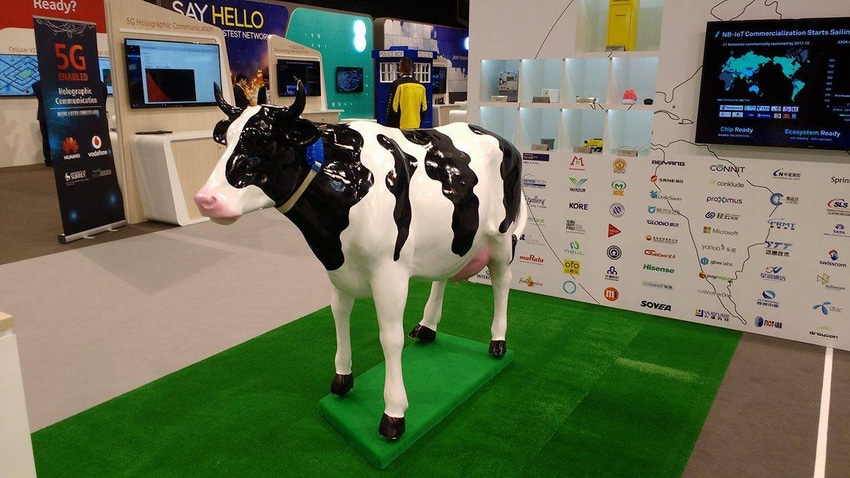Headline chasing aside Huawei Rotating CEO Ken Hu, speaking at the MBBF 2017 event, did have a point; the future isn’t that glum when you count how many things there are to connect out there.
November 15, 2017

Headline chasing aside Huawei Rotating CEO Ken Hu, speaking at the MBBF 2017 event, did have a point; the future isn’t that glum when you count how many things there are to connect out there.
After years of euphoria built on the transition from feature phones to the smartphone, trends have hit a bit of a wall. Hu highlighted that 120 countries around the world have greater than 100% smartphone penetration, but the infrastructure in the remaining ones if far too underdeveloped to make immediate fortunes. Some might look at this picture as quite dreary, but those are the ones who have limited imaginations apparently.
“If someone said there were another one billion subscribers out there, what would that make you think?” said Hu.
Here, Hu is talking specifically about cows, but more broadly about the opportunities which are presented through an IoT-driven economy. The cows are a good example of these opportunities. By using Huawei’s Estrus Monitoring System to connect a cow to the internet, farmers can keep better check on the health of the animal and semen deposition time, while also allowing it greater freedom to roam without concern of it coming into danger.
Using the NB-IoT network, the cow monitoring device can work for five years with a 5400mAH battery. There are obviously other benefits for the animal and the farmer, and Hu highlighted each cow connected in the study yielded $420 extra for the farmer in milk production.
This is a genuine usecase for 5G in a world where usecases are slim pickings so far. But what does this mean for the telcos? $10 ARPU for each animal which was connected, which include a service fee and the payback arrangement for each device. When you talk about 1 billion across the planet, all of a sudden these numbers start to become a bit more interesting.
And the business does not have to stop at dairy. What about the 100 million bicycles which are manufactured every year, or 300 million LED lampposts around the world, or the 20 million shipping containers. The promise of IoT is to connect everything, and everything you connect has an ARPU. It might be smaller amounts than connecting an individual, but when you are talking about 20-odd billion devices, there is a lot of money to be made from being a dumb pipe.
Hu of course wants the telcos to dream bigger than being a dumb pipe, but it isn�’t necessarily a bad business model. It’s low-risk and scalable.
“Opportunities are everywhere, the list goes on and on, the only limitation is our imagination,” said Hu. “New connections create new opportunities.
“But on the current network, we are not ready for IOT, and the current operational model is not sustainable.”
It’s something we have been discussing for a while, but of course digital transformation is still a hot topic. Current networks have been designed to connect people not places. The scale of the new ambitions cannot be managed by the current infrastructure or operational and maintenance models, which haven’t really changed in the last couple of years, despite the steps forward which have been taken by the industry.
It starts with the mindset, creating a new business model which is adaptable and offers platforms for all the various different applications which can be imagined by the more creative types of the world. This leads onto the need to foster closer relationships with the verticals themselves and the application developers who will enable this environment.
This is a very proactive change which needs to be made by the telco industry. Hu said it means removing the siloed concept of the telco vertical, and ensuring mobile is a horizontal technology, embedded into other verticals, to enable new business ideas and models.
The final change which needs to be made is to the network itself. As mentioned before, the current network could not enable an IoT world, therefore steps need to be taken to incorporate intelligence and move towards full autonomy. This is a network which self-optimizing and self-healing. The removal of human intervention would be preferable, as Hu noted 70% of faults are a result of human error.
This doesn’t say much for the network engineer of tomorrow, but to improve capabilities and intelligence on the network, we must be kept as far away from it as possible. For telcos to succeed in tomorrow’s world of IoT connectivity, artificial intelligence will be key.
“Our view is that AI is a general purpose technology,” said Hu. “Huawei is confident that in less than 10 years AI will be embedded and as widely used as we used computers today.”
This might be a big ask for the telcos, but let’s be honest, they have no choice. Hu highlighted the Chinese words for challenge and opportunity are the same, though the literal translation is ‘through challenge comes opportunity’. Perhaps this is the mentality which brought Huawei to the top of the world, and maybe the telcos could learn a thing or two about resilience.
About the Author(s)
You May Also Like








.png?width=300&auto=webp&quality=80&disable=upscale)


_1.jpg?width=300&auto=webp&quality=80&disable=upscale)


.png?width=800&auto=webp&quality=80&disable=upscale)